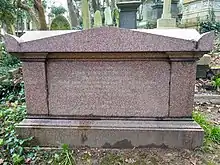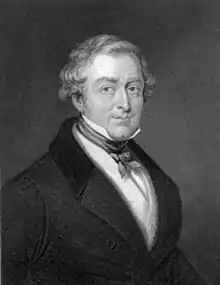John Copley, 1st Baron Lyndhurst
John Singleton Copley, 1st Baron Lyndhurst, PC, QS, FRS (21 May 1772 – 12 October 1863) was a British lawyer and politician. He was three times Lord High Chancellor of Great Britain.
The Lord Lyndhurst | |
|---|---|
 Lord Lyndhurst wearing the parliamentary robes of baron, portrait by Felix Rogge c.1836 | |
| Lord High Chancellor of Great Britain | |
| In office 2 May 1827 – 24 November 1830 | |
| Monarch | |
| Prime Minister | |
| Preceded by | The Earl of Eldon |
| Succeeded by | The Lord Brougham and Vaux |
| In office 21 November 1834 – 8 April 1835 | |
| Monarch | William IV |
| Prime Minister | Sir Robert Peel, Bt |
| Preceded by | The Lord Brougham and Vaux |
| Succeeded by | In Commission |
| In office 3 September 1841 – 27 June 1846 | |
| Monarch | Victoria |
| Prime Minister | Sir Robert Peel, Bt |
| Preceded by | The Lord Cottenham |
| Succeeded by | The Lord Cottenham |
| Personal details | |
| Born | 21 May 1772 Boston, Massachusetts British America |
| Died | 12 October 1863 (aged 91) London, United Kingdom |
| Nationality | British |
| Political party | Tory |
| Spouse(s) | Sarah Brunsden
(m. 1809; died 1834) Georgina Goldsmith (m. 1837) |
| Alma mater | Trinity College, Cambridge |
Background and education
Lyndhurst was born in Boston, Massachusetts, the son of painter John Singleton Copley and his wife Susanna Farnham (née Clarke), granddaughter of silversmith Edward Winslow. His father left America to live in London in 1774, and his wife and son followed a year later. Copley was educated at a private school and Trinity College, Cambridge,[1] where he graduated as second wrangler.
Political and legal career
Called to the bar at Lincoln's Inn in 1804, he gained a considerable practice. He was appointed a serjeant-at-law on 6 July 1813. In 1817 he was one of the counsel for Dr J. Watson, tried for his share in the Spa Fields riots. Lyndhurst's performance attracted the attention of Lord Castlereagh and other Tory leaders, and he entered parliament as member for Yarmouth in the Isle of Wight. He afterwards sat for Ashburton (1818–1826) and for Cambridge University (1826–1827).
In December 1818, Copley was made King's Serjeant and Chief Justice of Chester. He became Solicitor General on 24 July 1819 and was knighted in October, became Attorney General in 1824, Master of the Rolls in 1826 and Lord Chancellor in 1827. On his appointment to the latter post he was raised to the peerage as Baron Lyndhurst, of Lyndhurst in the County of Southampton.[2] As solicitor-general he took a prominent part in the trial of Queen Caroline and was opposed to the Liberal measures which marked the end of the reign of George IV and the beginning of that of William IV. He was Lord Chief Baron of the Exchequer from 1831 to 1834. During the Melbourne government from 1835 to 1841 he figured conspicuously as an obstructionist in the House of Lords. His former adversary Lord Brougham, disgusted at his treatment by the Whig leaders, soon became his most powerful ally in opposition. Lyndhurst held the chancellorship from 1827–1830, 1834–1835, and 1841–1846. As he was in regard to Catholic emancipation, so in the agitation against the Corn Laws, he opposed reform until Peel, his chief, gave the signal for concession. In 1837 he was Rector of Marischal College (later Aberdeen University).[3]


After 1846 and the disintegration of the Tory party over Peel's adoption of free trade, Lord Lyndhurst did not attend parliament sessions as often, but he continued to take a lively interest in public affairs and to make speeches. His address to the House of Lords on 19 June 1854, on the war with Russia, made a sensation in Europe, and throughout the Crimean War he was a strong advocate of the energetic prosecution of hostilities. In 1859 he denounced Napoleon III. His last speech was delivered in the House of Lords at the age of eighty-nine.
Family
In 1819 Lord Lyndhurst married Sarah, a daughter of Charles Brunsden and widow of Lieutenant-Colonel Charles Thomas, who was killed at Waterloo. She died in 1834, and three years later, in August 1837, he married secondly Georgiana Goldsmith (1807–1901), daughter of writer Lewis Goldsmith, of Paris. They had one daughter, Georgiana Susan Copley, who married Sir Charles Du Cane, Governor of Tasmania.[4]
Since his second wife came from a family of Jewish origins, it may be her influence which led Lyndhurst to support the Jewish Emancipation of 1858, when the law which had restricted the Parliamentary oath of office to Christians was changed, leading to the admission of Jews into parliament. Lyndhurst also advocated women's rights in questions of divorce.
He died in London on 12 October 1863 and was buried in Highgate Cemetery; as he left no son, his peerage became extinct. Lady Lyndhurst died in London 22 December 1901, aged 94.[4]
Arms
  |
|
References
- "Copley, John Singleton (CPLY790JS)". A Cambridge Alumni Database. University of Cambridge.
- "No. 18355". The London Gazette. 24 April 1827. p. 914.
- Officers of the Marischal College & University of Aberdeen, 1593-1860.
- "Obituary – Lady Lyndhurst". The Times (36645). London. 23 December 1901. p. 7.
- Debrett's Peerage. 1847.
 This article incorporates text from a publication now in the public domain: Chisholm, Hugh, ed. (1911). "Lyndhurst, John Singleton Copley". Encyclopædia Britannica. 17 (11th ed.). Cambridge University Press. p. 170.
This article incorporates text from a publication now in the public domain: Chisholm, Hugh, ed. (1911). "Lyndhurst, John Singleton Copley". Encyclopædia Britannica. 17 (11th ed.). Cambridge University Press. p. 170.
Further reading
- Dennis Lee: Lord Lyndhurst: The Flexible Tory – ISBN 0-87081-358-7, 318 pages – 1994 Niwot (Colorado): University Press of Colorado.
External links
| Wikimedia Commons has media related to John Singleton Copley, Baron Lyndhurst. |
| Wikisource has original works written by or about: John Copley, 1st Baron Lyndhurst |
- "Archival material relating to John Copley, 1st Baron Lyndhurst". UK National Archives.

- Hansard 1803–2005: contributions in Parliament by John Copley
![]() This article incorporates text from a publication now in the public domain: Chisholm, Hugh, ed. (1911). "Lyndhurst, John Singleton Copley". Encyclopædia Britannica. 16 (11th ed.). Cambridge University Press. p. 170.
This article incorporates text from a publication now in the public domain: Chisholm, Hugh, ed. (1911). "Lyndhurst, John Singleton Copley". Encyclopædia Britannica. 16 (11th ed.). Cambridge University Press. p. 170.
.svg.png.webp)
